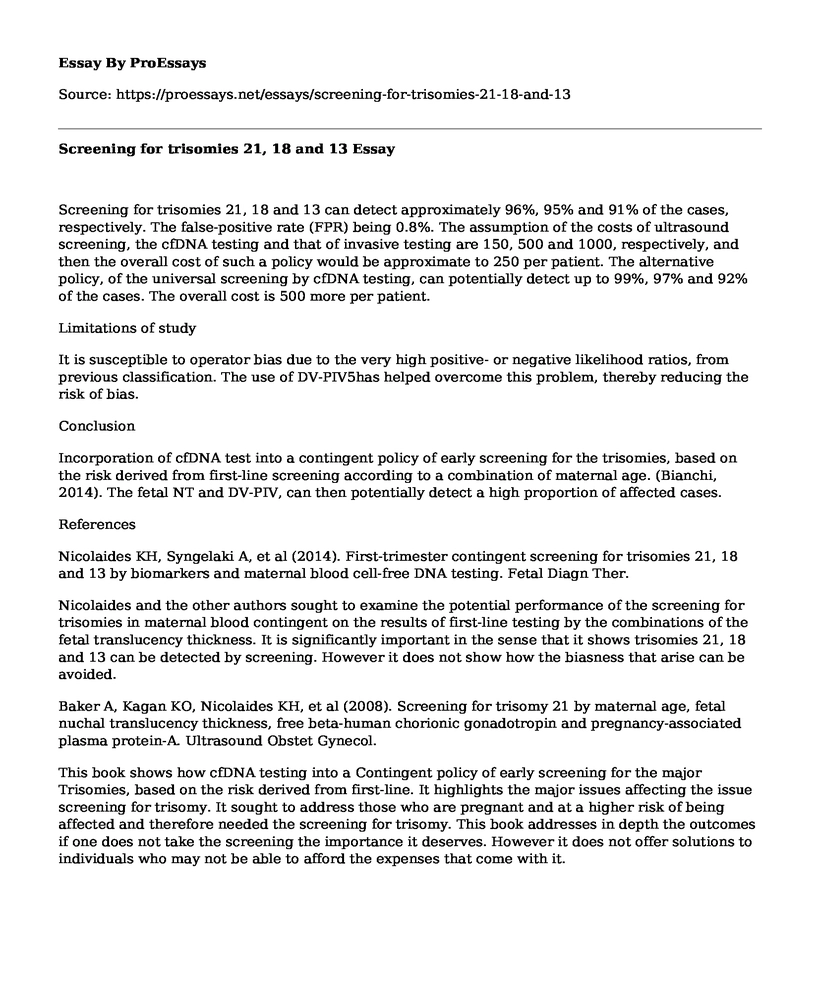Screening for trisomies 21, 18 and 13 can detect approximately 96%, 95% and 91% of the cases, respectively. The false-positive rate (FPR) being 0.8%. The assumption of the costs of ultrasound screening, the cfDNA testing and that of invasive testing are 150, 500 and 1000, respectively, and then the overall cost of such a policy would be approximate to 250 per patient. The alternative policy, of the universal screening by cfDNA testing, can potentially detect up to 99%, 97% and 92% of the cases. The overall cost is 500 more per patient.
Limitations of study
It is susceptible to operator bias due to the very high positive- or negative likelihood ratios, from previous classification. The use of DV-PIV5has helped overcome this problem, thereby reducing the risk of bias.
Conclusion
Incorporation of cfDNA test into a contingent policy of early screening for the trisomies, based on the risk derived from first-line screening according to a combination of maternal age. (Bianchi, 2014). The fetal NT and DV-PIV, can then potentially detect a high proportion of affected cases.
References
Nicolaides KH, Syngelaki A, et al (2014). First-trimester contingent screening for trisomies 21, 18 and 13 by biomarkers and maternal blood cell-free DNA testing. Fetal Diagn Ther.
Nicolaides and the other authors sought to examine the potential performance of the screening for trisomies in maternal blood contingent on the results of first-line testing by the combinations of the fetal translucency thickness. It is significantly important in the sense that it shows trisomies 21, 18 and 13 can be detected by screening. However it does not show how the biasness that arise can be avoided.
Baker A, Kagan KO, Nicolaides KH, et al (2008). Screening for trisomy 21 by maternal age, fetal nuchal translucency thickness, free beta-human chorionic gonadotropin and pregnancy-associated plasma protein-A. Ultrasound Obstet Gynecol.
This book shows how cfDNA testing into a Contingent policy of early screening for the major Trisomies, based on the risk derived from first-line. It highlights the major issues affecting the issue screening for trisomy. It sought to address those who are pregnant and at a higher risk of being affected and therefore needed the screening for trisomy. This book addresses in depth the outcomes if one does not take the screening the importance it deserves. However it does not offer solutions to individuals who may not be able to afford the expenses that come with it.
Cite this page
Screening for trisomies 21, 18 and 13. (2021, Mar 06). Retrieved from https://proessays.net/essays/screening-for-trisomies-21-18-and-13
If you are the original author of this essay and no longer wish to have it published on the ProEssays website, please click below to request its removal:
- Opioid Problem in the United States Essay
- Paper Example on Financial Ratios for Pharmaceutical Industry
- Paper Example on Infectious Diseases
- Community Healthcare Issues Paper Example
- Paper Example on Low-Income Earners & Access to Medical Care: A Solution With Medicaid
- World Bank Supports Fight Against Neglected Tropical Diseases - Essay Sample
- Midlife Physical Decline: Strategies to Reduce Negative Effects - Essay Sample







